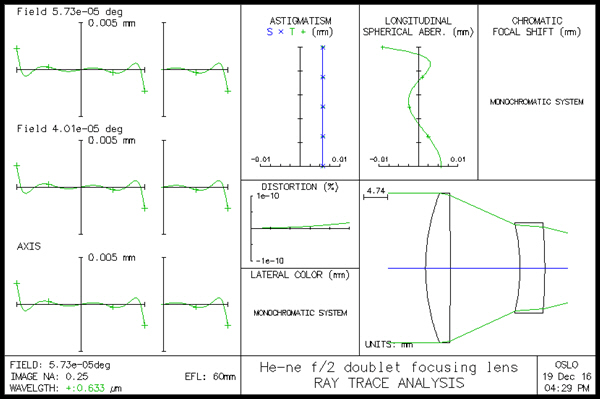Lasrdblt is the final design of the air-spaced doublet. The example here uses this design to illustrate the thermal analysis capabilities of OSLO. The lasrdblt.len file is the finished design from the air-spaced doublet study presented elsewhere. You can see from the ray analysis below that the lens far outperforms the Cooke triplet, double Gauss, and Petzval lenses shown in these examples. On the other hand, it has essentially no field of view, and works only in monochromatic light. These limitations distinguish the present design from normal doublets, which are usually designed to cover an extended spectral range. In the present lens, the degrees of freedom normally used to extend the spectral range were instead used to balance high-order aberrations.

The air-spaced doublet provides a good system to illustrate the thermal or environmental analysis features in OSLO. When the temperature of the lens and its environment is changed, OSLO changes the lens data according to the thermal expansion of the materials (glass and spacers) used to construct it. In addition, refractive indices are recalculated to account for the thermal variation of refractive index. The temperature of the lens and its surroundings can be set by changing the Temperature value in the General Operating Conditions spreadsheet. To see the effect of temperature changes on the laser doublet, open the lasrdblt.len file and execute the Calculate >> Paraxial command to print the paraxial constants PARAXIAL CONSTANTS
| Effective focal length: |
60.000049 |
Lateral magnification: |
-6.0000e-19 |
| Numerical aperture: |
0.250000 |
Gaussian image height: |
6.0000e-05 |
| Working F-number: |
2.000002 |
Petzval radius: |
-205.107372 |
| Lagrange invariant: |
-1.5000e-05 |
|
|
Now open the general operating conditions spreadsheet and change the temperature of the system to 100 degrees. Repeat the above command: PARAXIAL CONSTANTS
| Effective focal length: |
59.975811 |
Lateral magnification: |
-5.9976e-19 |
| Numerical aperture: |
0.250101 |
Gaussian image height: |
5.9976e-05 |
| Working F-number: |
1.999194 |
Petzval radius: |
-205.187615 |
| Lagrange invariant: |
-1.5000e-05 |
|
|
If the focal length of the original system is in spreadsheet cell, enter the following prt;prt "Focal length change =" a5-a1 which produces Focal length change = -0.024238 Now click on the SHIFT+F12 icon to autofocus the system: *AUTOFOCUS Optimal focus shift = -0.130511 Note that although the focal length only changes by 24 micrometers, it takes a focal shift of 130 micrometers to refocus the system. Evidently the aberration balance has been changed, as you can verify using the Report Graphics command. Now change the temperature back to 20 degrees. You will see that the lens data do not return exactly to their previous values. This is caused by round-off effects in the expansion calculations. You should always save the original system in a file before changing the temperature, or leave the operating conditions spreadsheet open during your analysis and cancel out of it at the end. If you plan extensive thermal analysis, you should consult the tem command in the help system or see the Program Reference manual for additional options.

